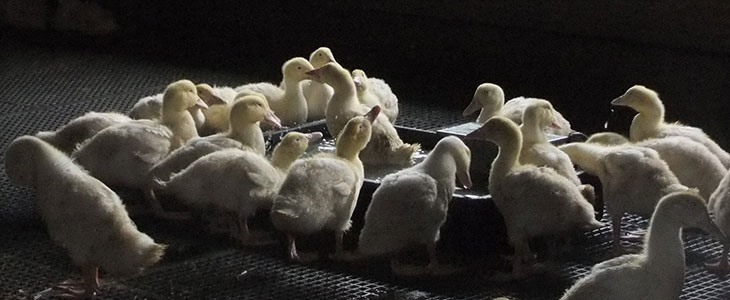How To Win Friends And Influence Ducklings

Guiomar Liste
(Inside Science) -- When ducklings head out to bathe in a pool, they usually follow the same individual, new research has found. But do they visit the pool that’s best for everyone, or just the one their chief prefers? This puzzle has made it hard for farmers to know how to provide for all their ducks equally, and for biologists to know what social animals really want.
Originally, the researchers wanted to know whether ducks prefer deep pools where they can swim, or shallow pools where they can put their feet down. They divided ducklings into 12 groups of four, and placed them in enclosures with access to two pools of different depths. The Royal Society for the Prevention of Cruelty to Animals funded the research to guide new standards for humane duck farming.
Contrary to expectations, the ducks seemed to prefer shallow pools. But the researchers noticed something else: When the ducklings went out to bathe, they all moved together.
"That raises the question, 'When a group of animals is making a decision, is it actually only one individual that makes the decision, and the others then follow? Or do they all make independent decisions and come to the same conclusion?'" said Donald Broom, professor emeritus of animal welfare at Cambridge University in the U.K. and one of the study's authors.
If each duckling makes its own decision, then the results are clear: Ducklings like shallow water. If they have leaders, things get murkier, because the leader’s choice might not be what the followers would choose for themselves.
To see how ducklings make decisions, the researchers re-analyzed the original study videos. They found that all 12 duckling groups had one clear leader who tended to lead the way to the bathing pools. In nine of the groups, the leader initiated the majority of the group’s movements on every observation day. In the remaining three groups, the leaders were less consistent, but still initiated most of their group’s movements on most observation days. The results were published online in the journal Ethology earlier this year.
"We were fairly surprised," said Guiomar Liste, who conducted the study as a postdoctoral researcher at Cambridge. "They are all of the same breed, the same strain. They are really similar, so it's not the type of situation where you expect strong leadership to arise."
For social animals, group living confers advantages such as protection from predators. But it can carry costs too, because not all individuals have identical needs. For example, deer with different body sizes need to spend different amounts of time foraging and lying still to ruminate. If animals have leaders and there are systematic differences between the needs of leaders and followers, scientists might not pick up on the needs of each animal in a group.
The obvious solution is to test animals individually. But when animals accustomed to living in social groups are isolated, they become anxious and don’t behave normally. Domestic ducks and most other farm animals are too social to be tested on their own.
So do follower ducks actually need deep pools, despite the fact that their leaders prefer shallow pools? Probably not, according to the researchers. Because they were so similar, the ducklings most likely had similar needs and desires. Furthermore, duckling leaders are not bullies; they can only lead if others choose to follow.
"If the leader just goes off and the followers decide not to follow it, then in most animal groups, a leader can't do much about it. It's more of a consensual decision than might meet the eye," said Larissa Contradt, a research fellow who studies collective decision-making in animals at the Max Planck Institute in Berlin and was not involved in the duckling study.
According to Conradt and Broom, animals often follow a particular individual because that animal has more information and makes better decisions on behalf of the whole group.
Still, without further studies, the researchers can't be sure their results represent the needs of follower ducks. Leadership and group dynamics are issues that researchers often overlook when testing animals' preferences, according to Liste. No one expected the ducklings to have leaders. The fact that they did highlights the need to pay attention to how animals influence one another’s decisions.
This type of research has applications beyond farming. For example, conservation workers are better able to predict the movements of wild animals when they understand how groups make decisions, according to Conradt.
These insights may even help explain the basic principles behind group decisions made by another social species: humans. However, in humans, the underlying mechanisms are obscured by language and culture. Therefore, it is simpler to study collective decision-making in other animals, said Conradt.
Using simpler animals, such as ducks, as models may offer a way to study the foundations of sociality across species, including our own.
Nala Rogers is a science writer based in Santa Cruz, California. She tweets at @Nala_Rogers.
